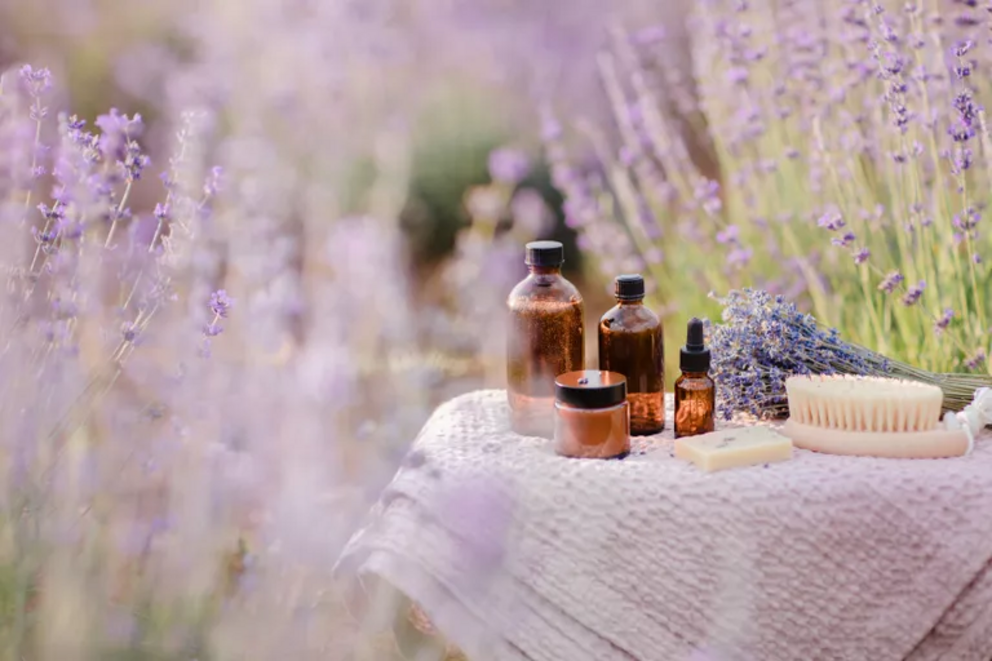How to make lavender essential oil in three easy steps
Overview
- Working Time: 45 minutes - 1 hour
- Total Time: 1 minute - 1 hour, 30 minutes
- Yield: 1.5-2 cups
- Skill Level: Beginner
- Estimated Cost: $10-20
Adding a little bit of lavender essential oil to your hair and skincare regimen is an easy way to put the power of natural plant compounds to work while avoiding harsh chemicals. And you can feel good about the environmental sustainability of lavender essential oil, as the plant does not rely on heavy amounts of fertilizers and pesticides.1
The benefits of lavender essential oil include its antimicrobial properties.2 Diluting lavender essential oil with a carrier oil and massaging it into hair may help to prevent scalp issues like dandruff. Lab studies have also shown that lavender essential oil may stimulate hair growth.3 The oils found in lavender may also help reduce inflammation and irritation on the skin.4
The light purple flower comes from a plant that belongs to the mint family. The most commonly grown species is Lavandula angustifolia, or English lavender, but there are many varieties that are grown around the world. Using it to make your own essential oil is super easy if you follow our basic recipe that just requires dried flowers and a carrier oil.
Which Carrier Oil Should You Use?
There are a number of carrier oils that you can use to make your lavender oil. The type of oil you choose will depend on what benefits you are looking to get and what type of skin or hair you have. Cold-pressed oils with no additives or preservatives are the best kind to use for beauty applications.
Different carrier oils have different effects on the skin, depending on skin type and the comedogenic properties of the oil. It may be necessary to try out a few types of oil before you find one that works best for your skin and hair. Some oils can irritate the skin and scalp and should be avoided if you have sensitive skin.
Olive oil contains a variety of vitamins such as A, D, E, and K as well as fatty acids. It does tend to have a strong scent, so it might not be the best option if you’re looking to really have the lavender scent shine through. Though if your intention is to use the lavender oil in your cooking instead of beauty applications, olive oil is a wonderful option.
Unrefined coconut oil is not processed with chemicals. It has lauric acid which exhibits antibacterial and antimicrobial properties and beneficial fatty acids.
Sweet almond oil is lightweight and a great option for skin treatments. It has lots of omega-3 fatty acids and vitamin E.
Jojoba oil is rich in vitamins B, C, and E and can help moisturize both hair and skin. It is not pore-clogging and absorbs easily.
It's a good idea to look at the benefits and potential drawbacks of each carrier oil before buying one. Most can be purchased at a grocery store or specialty foods store.
What You'll Need
Tools/Supplies
- Glass pint jar with lid
- Nut milk bag or cheesecloth
- Medium bowl
- Medium saucepan
- Measuring cups
Ingredients
- 1 cup carrier oil (any type)
- 2 cups dried lavender buds or dried flowers (organic is preferable)
Instructions
Heat Your Carrier Oil
Use a measuring cup to add your chosen carrier oil to the saucepan and place the saucepan on a burner.
Heat the carrier oil on medium until it begins to bubble slightly. Be careful not to introduce moisture into the oil, as the oil may splatter.
Add the Lavender
Add the dried lavender to the saucepan of carrier oil and stir. Simmer uncovered for 30 minutes (you may need to turn down the heat to low).
Cool mixture to room temperature.
Strain
Over a medium bowl, pour cooled mixture into a nut bag or cheesecloth to strain out the lavender flowers. You may need to strain twice if you want the oil to have fewer particles.
Store your oil in the glass pint jar in a cool, dark place.
Keep in Mind
Always do a patch test to determine if an oil is right for you to use before applying a large amount of it to your skin. You can perform a patch test by applying a small amount of the oil in a discreet place like the inside of your wrist. Cover the oil and let it sit for 24 hours before checking for irritation. If any redness or sensitivity occurs, avoid using that oil as a carrier for your products.
For full references please use source link below.

